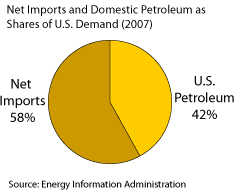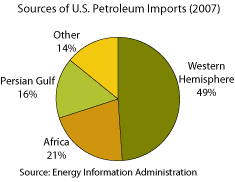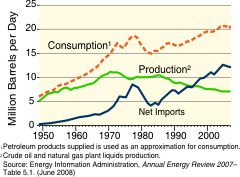



The United States consumed 20.7 million barrels per day (MMbd) of petroleum products during 2007 making us the world’s largest petroleum consumer. The United States was third in crude oil production at 5.1 MMbd. But crude oil alone does not constitute all U.S. petroleum supplies. Significant gains occur, because crude oil expands in the refining process, liquid fuel is captured in the processing of natural gas, and we have other sources of liquid fuel, including biofuels. These additional supplies totaled 3.6 MMbd in 2007. However, we still needed 13.5 MMbd of imported crude oil and petroleum products to meet U.S. demand. The United States also exported 1.4 MMbd of crude oil and petroleum products during 2007, so our net imports (imports minus exports) equaled 12.0 MMbd.
Petroleum products imported by the United States during 2007 included gasoline, diesel fuel, heating oil, jet fuel, chemical feedstocks, asphalt, and other products. Still, most petroleum products consumed in the United States were refined here. Net imports of petroleum other than crude oil were 10% of the petroleum consumed in the United States during 2007.
About Half of U.S. Petroleum Imports Come from the Western Hemisphere
Some may be surprised to learn that almost 50% of U.S. crude oil and petroleum products imports came from the Western Hemisphere (North, South, and Central America and the Caribbean including U.S. territories) during 2006. We imported only 16% of our crude oil and petroleum products from the Persian Gulf countries of Bahrain, Iraq, Kuwait, Qatar, Saudi Arabia, and United Arab Emirates. During 2007, our five biggest suppliers of crude oil and petroleum products were:
- Canada (18.2%)
- Mexico (11.4%)
- Saudi Arabia (11.0%)
- Venezuela (10.1%)
- Nigeria (8.4%)
It is usually impossible to tell whether the petroleum products you use came from domestic or imported sources of oil once they are refined.
Flat U.S. Petroleum Imports Expected
The Energy Information Administration (EIA) projects U.S. crude oil and petroleum products imports will hold approximately steady in the next two decades. Total U.S. petroleum consumption is expected to increase 2.1 MMbd by 2030. Meanwhile, U.S. crude oil production increases in the Gulf of Mexico and elsewhere, combined with increasing biofuel and coal-to-liquids (CTL) production, are expected to eliminate the need for increased imports over the longer term. Assuming moderate price increases, U.S. net imports of crude oil and petroleum products will decrease slightly to 12.3 MMbd to meet demand of 22.8 MMbd by 2030. In this case, U.S. petroleum import dependence will fall from nearly 60% in 2006 to 54% by 2030.
1 See the EIA Glossary for comprehensive definitions of “petroleum,” “oil,” “petroleum products,” and “crude oil.”
